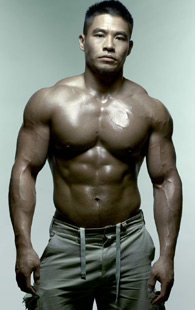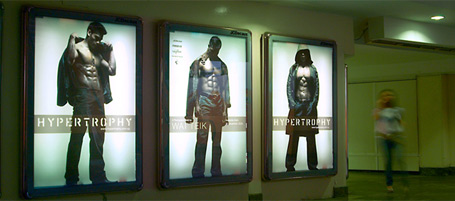Having shot for major brands such as Levi's, Sony, MTV to international advertising agencies such as Saatchi & Saatchi and Ogilvy & Mather to government statutory boards such as Republic of Singapore Navy, photographer Chan Wai Teik has set a career milestone with his new book Hypertrophy.

Known simply as Wai Teik in the industry, the bodybuilder-photographer shares his views on Asian male musculature, and the industry's preference of using Caucasian models over Asian ones in advertisements and myths about bodybuilding.
æ: ASOL (Age, Sex, Occupation, Location)
Wai Teik: 34, male, fashion photographer, Singapore
æ: Your first photo book, Hypertrophy, features six competitive bodybuilders - many of whom have won awards at MuscleMania Asia as well as the South East Asian and Commonwealth Games in recent years. How did the idea come about and can you elaborate on how it was conceptualised?
Wai Teik: My first camera was given to me as a gift when I was about 12 and I started going to the gym when I was about 17 years old. Hence my encounters with both fashion photography and bodybuilding were when I was relatively young.
There are numerous coffee table books in the market that feature the male physique, however, very few feature the Asian male physique. Hence I conceptualised the idea of showcasing Asian musculature from a fashion perspective. There are fashion elements peppered throughout the book - from the utilitarian dog tag to the luscious Roberto Cavalli jacket. The book is subtly segregated into chapters by dividers. The chapter dividers are inspiration drawn from the cross-hatching found on the grips of barbells. This graphic element is found in varying sizes in the book as well as the website dedicated to the book. The book opens with a macro view of musculature, pulls out to reveal the human form pelted sensuously by water and ends with the full-length view of the flying models clad in jackets.
Numerous brainstorming sessions took place between the designer of the book (Neighbor) and I. A few concepts of the book were mooted. One concept was to embed pieces of metal into the book so the book looks feather-light to the eye but was actually very heavy when lifted. However the production as well as freight costs ruled out its practicality.
æ: How did you select the six models to appear in the book and what were you looking for?
Wai Teik: The basic criterion for the models was they had to look muscular. Most of the models I photograph for my other projects will be deemed "too anorexic" for this book. That said, not everyone who appears muscular is photogenic. Vascularity plays a major role in making the pictures work. This is the state in which the athletes display veins that protrude from the muscles due to their dietary habits and cardiovascular activities. This brings me to the point of timing. Most of the athletics appear in this stage only for a short span of time, especially before and during competition. Hence, I had to schedule the photography sessions when their bodies are primed for contest. The models had to look at ease in front of the camera. This takes quite a lot of coaxing and when they saw the great results, they were pleased and wanted to have more shots taken.
æ: Being a bodybuilder yourself, what are the main elements you want to highlight to readers?
Wai Teik: The main reason I wanted to do the book was to put the Asian musculature on the pedestal. There is no platform for them to showcase their years of toiling. I wanted to demonstrate that the Asian male is not as frail, pallid and emasculated as what some people perceive to be. There are a lot of Asian athletes who will do the community proud. The way these athletes look are the result of years of careful and calculated planning and punishments. Hence I am here to pay tribute to them for their perseverance and dedication.
æ: In an interview with a Singapore newspaper, you made a remark that despite Singapore being an Asian society, most of the models you work with are typically either pan-Asian or Caucasian. Why do you think that is?
Wai Teik: Indeed, I mentioned that most of the fashion and commercial shoots tend to favour the pan-Asian or Caucasian look as compared to the Asian one. This might have stemmed from the fact that most people perceive images with Caucasian models to be more up market. My Asian friends, who know I am in the industry, have told me they cannot relate to the products that are advertised using Caucasian models. There is a misconception that by using Caucasian models, the status of the brand is elevated instantaneously. What sells a brand is its overall design, the message that it is trying to convey as well as the brand values that it embraces.
æ: How can aware consumers, photographers and anyone in the creative or marketing process make a difference in changing that practice/mindset?
Wai Teik: By understanding what the brand is trying to achieve and by knowing its target audience, everyone in the creative process can make a difference. I've found that a similar recurring problem with some of the projects I've taken up is the lack of or breakdown of communication between the seller of the product and the person executing the look of the finished product. This could be due to too many layers of bureaucracy involved in the planning of the creative process.
æ: Are there any myths about bodybuilding you would like to dispel?
Wai Teik: There has been a surprising level of ignorance displayed towards this sport. I have been posed too many a time this question, "can I look like that in three months?" Too many people have the misconception that there are shortcuts and easy ways to look like a bodybuilder within a short time span. What they fail to understand is that in order to attain a body with proportionate huge muscle mass and vascularities, it takes a great deal of time and effort. People who will not tolerate the long hours of toiling at the gym and those who can't withstand the onset of muscle aches will very unlikely succeed in this sport. They must to a certain extent enjoy the regiment of disciplined training and pain in order to see results that will last in the long run.
æ: Coming back to photography, how did you get into it?
Wai Teik: I got my first camera when I was about 12. Two years later, my dad gave me his old camera, a Canon AE-1. It is a great camera that is both light and versatile but unfortunately no longer in production. It was this camera that ignited my passion for photograph.
æ: Which celebrity would you most like to photograph and why?
Wai Teik: Bjork for her quirkiness and her ability to engage me most of the time. Yamagishi Hidetada (a professional Japanese bodybuilder) for his superb dedication to bodybuilding.
æ: What tips do you have for photographers who want to get into fashion and celebrity photography?
Wai Teik: I only have one word that sums it up: passion. It is passion that drives me to work; the financial gain that comes with it is secondary. Passion is the single driving force that can allow any photographer to craft his unique style.
æ: What inspires you?
Wai Teik: Films are a big inspiration to me. Not the big budget Hollywood types but the independent, foreign films. I am a big fan of Park Chan Wook, Korean film director who did "Sympathy for Lady Vengeance." His unexpected narratives, stunning visuals are a sight to behold. Besides that, simple things in life inspire me. Breeze coursing through the reservoir waters, leaves falling onto the forest floors, shafts of moonlight permeating through the air well�
æ: If you could do it all over again, what would you change?
Wai Teik: I would probably like to practise photography overseas.
æ: What was the most important thing that happened to you in the last 12 months?
Wai Teik: It must be the launch of the new photography book. Seeing the books displayed in Page One is a big satisfaction that has been a long time coming. The making of the book took about two years - the bulk of it went to soliciting for sponsorships, setting up of the web site (www.hypertrophy.com.sg) and seeking legal advice. The launch of the book meant a great deal to me - and it signifies the beginning not the end.
æ: What's your biggest guilty pleasure?
Wai Teik: I think it would be Peking duck. The crispy roasted skin wrapped in popiah skin dipped in sweet sauce - nice!
æ: Some people who have seen your photograph -which appears on the bio page in the book - are wondering if you would consider appearing in a future photobook project. What do you say to that?
Wai Teik: I would not rule out that possibility. If there is anyone who is interested to embark on such a project, please do not hesitate to contact me. I don't bite!
Hypertrophy is sold at boutique shops such as Venue Lab at The Heeren, The Asylum at 22 Ann Siang Road and online at www.hypertrophy.com.sg. The recommended retail price is S$120.

